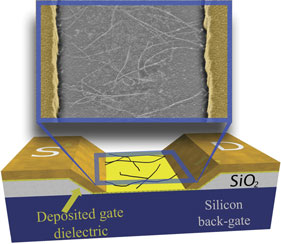Crossref Citations
This article has been cited by the following publications. This list is generated based on data provided by
Crossref.
Cress, C. D.
Champlain, J. G.
Esqueda, I. S.
Robinson, J. T.
Friedman, A. L.
and
McMorrow, J. J.
2012.
Total Ionizing Dose Induced Charge Carrier Scattering in Graphene Devices.
IEEE Transactions on Nuclear Science,
Vol. 59,
Issue. 6,
p.
3045.
McMorrow, Julian J.
Cress, Cory D.
and
Affouda, Chaffra A.
2012.
Charge Injection in High-κ Gate Dielectrics of Single-Walled Carbon Nanotube Thin-Film Transistors.
ACS Nano,
Vol. 6,
Issue. 6,
p.
5040.
Rossi, Jamie E.
Cress, Cory D.
Helenic, Alysha R.
Schauerman, Chris M.
DiLeo, Roberta A.
Cox, Nathanael D.
Messenger, Scott R.
Weaver, Brad D.
Hubbard, Seth M.
and
Landi, Brian J.
2012.
Ion irradiation of electronic-type-separated single wall carbon nanotubes: A model for radiation effects in nanostructured carbon.
Journal of Applied Physics,
Vol. 112,
Issue. 3,
Cress, Cory D.
McMorrow, Julian J.
Robinson, Jeremy T.
Landi, Brian J.
Hubbard, Seth M.
and
Messenger, Scott R.
2012.
Radiation Effects in Carbon Nanoelectronics.
Electronics,
Vol. 1,
Issue. 1,
p.
23.
Islam, Ahmad
2013.
Variability and Reliability of Single-Walled Carbon Nanotube Field Effect Transistors.
Electronics,
Vol. 2,
Issue. 4,
p.
332.
Francis, S. Ashley
Cress, Cory D.
McClory, John W.
Moore, Elizabeth A.
and
Petrosky, James C.
2013.
Characterization of Radiation Damage in Carbon Nanotube Field-Effect Transistors.
IEEE Transactions on Nuclear Science,
Vol. 60,
Issue. 6,
p.
4087.
Cress, Cory
2014.
Carbon Nanoelectronics.
Electronics,
Vol. 3,
Issue. 1,
p.
22.
Francis, S. Ashley
Petrosky, James C.
McClory, John W.
and
Cress, Cory D.
2014.
Effects of Proton and X-ray Irradiation on Graphene Field-Effect Transistors with Thin Gate Dielectrics.
IEEE Transactions on Nuclear Science,
Vol. 61,
Issue. 6,
p.
3010.
Bushmaker, Adam W.
Walker, Don
Mann, Colin J.
Oklejas, Vanessa
Hopkins, Alan R.
Amer, Moh. R.
and
Cronin, Stephen B.
2014.
Single Event Effects in Carbon Nanotube-Based Field Effect Transistors Under Energetic Particle Radiation.
IEEE Transactions on Nuclear Science,
Vol. 61,
Issue. 6,
p.
2839.
Cox, Nathanael D.
Rossi, Jamie E.
Cress, Cory D.
Merrill, Andrew
Crompton, Kyle R.
and
Landi, Brian J.
2014.
Spatially Selective Au Nanoparticle Deposition and Raman Analysis of Ion-Irradiated Single-Wall Carbon Nanotubes.
The Journal of Physical Chemistry C,
Vol. 118,
Issue. 25,
p.
14031.
Ishii, Satoshi
Yabe, Daisuke
Koshio, Shigeki
Hirao, Toshio
Enomoto, Shotaro
Konishi, Teruaki
and
Hamano, Tsuyoshi
2015.
Total Ionizing Dose Effects in Carbon Nanotube Network Transistors.
p.
1.
Bushmaker, Adam W.
Oklejas, Vanessa
Walker, Don
Hopkins, Alan R.
Chen, Jihan
and
Cronin, Stephen B.
2015.
Radiation Induced Single Ion Surface Effects in Nanoelectronic Circuits.
IEEE Transactions on Nuclear Science,
Vol. 62,
Issue. 6,
p.
2926.
LaGasse, Samuel W.
Cress, Cory D.
Hughes, Harold L.
and
Lee, Ji Ung
2015.
Atomistic Modeling of Suspended Carbon Nanotube Field Effect Transistors Under Proton Radiation.
IEEE Transactions on Nuclear Science,
Vol. 62,
Issue. 6,
p.
2881.
Rossi, Jamie E.
Cress, Cory D.
Merrill, Andrew
Soule, Karen J.
Cox, Nathanael D.
and
Landi, Brian J.
2015.
Intrinsic diameter dependent degradation of single-wall carbon nanotubes from ion irradiation.
Carbon,
Vol. 81,
Issue. ,
p.
488.
Zhao, Yudan
Li, Dongqi
Xiao, Lin
Liu, Junku
Xiao, Xiaoyang
Li, Guanhong
Jin, Yuanhao
Jiang, Kaili
Wang, Jiaping
Fan, Shoushan
and
Li, Qunqing
2016.
Radiation effects and radiation hardness solutions for single-walled carbon nanotube-based thin film transistors and logic devices.
Carbon,
Vol. 108,
Issue. ,
p.
363.
Islam, Ahmad Ehteshamul
2016.
Current Status of Reliability in Extended and Beyond CMOS Devices.
IEEE Transactions on Device and Materials Reliability,
Vol. 16,
Issue. 4,
p.
647.
Vishalli
Kaur, Ramneek
Raina, K.K.
Avasthi, D.K.
Jeet, Kiran
Srivastava, Alok
and
Dharamvir, Keya
2016.
Study of Single Walled Carbon Nanotubes Irradiated by Swift Heavy Ions.
Materials Today: Proceedings,
Vol. 3,
Issue. 6,
p.
2062.
Alexandrou, Konstantinos
Masurkar, Amrita
Edrees, Hassan
Wishart, James F.
Hao, Yufeng
Petrone, Nicholas
Hone, James
and
Kymissis, Ioannis
2016.
Improving the radiation hardness of graphene field effect transistors.
Applied Physics Letters,
Vol. 109,
Issue. 15,
Hopkins, A.R.
Labatete-Goeppinger, A.C.
Kim, H.
and
Katzman, H.A.
2016.
Space survivability of carbon nanotube yarn material in low Earth orbit.
Carbon,
Vol. 107,
Issue. ,
p.
77.
McMorrow, Julian J.
Cress, Cory D.
Arnold, Heather N.
Sangwan, Vinod K.
Jariwala, Deep
Schmucker, Scott W.
Marks, Tobin J.
and
Hersam, Mark C.
2017.
Vacuum ultraviolet radiation effects on two-dimensional MoS2 field-effect transistors.
Applied Physics Letters,
Vol. 110,
Issue. 7,
